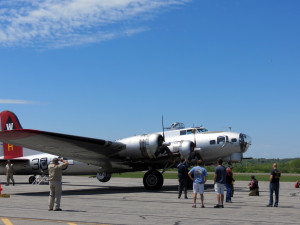
By: Sidney Smith- June, 2015
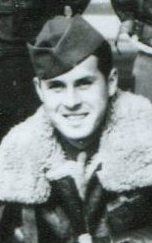
A young kid of 19 years old, like so many of the young guys my mother and I had met, was being assigned to the 8th AF and sent to England; a kid named Larry from Easton, Maine. His orders had to have read something along these lines:
“Cogswell, Lawrence H., PFC,, 8th AF, 45th Combat Wing, 452nd Bomb Group, 730th Bomb Squadron, Captain Hayes, Ralph S., Jr., Commanding Officer, AF Station 142.” Once in England, Larry discovered that “Air Force Station 142” was at an airfield in East Anglia known as Deopham Green. It was a somewhat rural place in 1944 and the crew quarters were in what was known at the time as Quonset (or sometimes Nissen) huts. Each hut housed twenty guys and at least most of the huts had poured concrete floors. Heating was by a small British coke-fired stove and given British weather, was never quite adequate.
Firewood was scarce (at that time most Brits did not have much if any). There was no hot water either, but there was a standing (and firm) order that all aircrew were to be clean-shaven. Thus, shaving before missions was always considerably less than pleasant. That order was not through any undue care about personal hygiene and appearance, but rather due to the fact that most missions were to be flown at high altitude … and oxygen masks had to fit, and fit well, or you were likely to die from anoxia. Missions lasted for hours, and many of them were flown at well over 20,000 feet. It is hard to imagine today a dress requirement, the ignorance of which could result in nothing short of an extremely unpleasant death. And everyone on the aircrew of a B-17 had an essential position. One man down meant one position or weapon unavailable and that drove the odds up against you, odds that were already none too good.
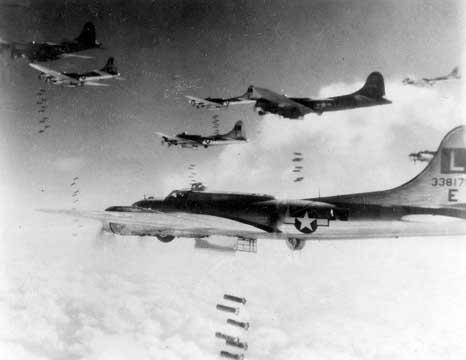
Regardless of what we on the home front were told at the time, the crews considered the food terrible, consisting mostly of powdered eggs and potatoes (and probably sometimes peas). In fact, there grew up a sort of cottage industry, derived from the fine old British tradition of poaching game, as several of the guys would quietly raid the adjoining landowner’s game park and poach a few pheasants for the larder. Larry was also to learn that on-board rations during missions consisted solely of hard candy because anything else would probably require a relief call of nature and that the temperatures at altitude made frostbite an all-too-real genuine risk.
Frostbite was almost as serious a threat as the actual enemy! There was one mission where the indicated outside air temperature was -85° F. Imagine an average temperature of around 85 below zero and having to stand near or at an open window for hours with the wind howling by at somewhere around one hundred fifty miles per hour.
Try that for a wind chill factor!
There was often clouds and quite some fog and lots of rain, which meant that too much flying had to be done under considerably less than optimum conditions. In translation, that meant that many missions were flown in which the first genuinely dangerous event consisted of climbing up through the fog and cloud cover without colliding with some other B-17. Those collisions were very nearly always fatal to both airplanes. To this day there are several local churches around East Anglia with windows or plaques dedicated to the memories of aircrews killed before they had even been able to get out of British airspace.
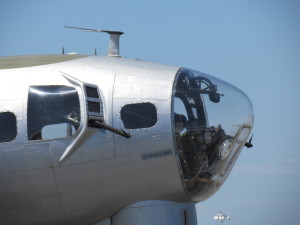
I am certain that, even then, Larry was a quietly affable young guy and he must have seen several of the other B-17’s at Deopham Green with their always colorful and imaginative “nose art” such as: “E-Rat-Icator”, “Sunrise Serenade”, “Dog Breath”, “Scrappy Jr.”, “Flatbush Floogie”, “Now Go!”, “3 Cads and a Lad”, “Mugwump”, “Sack Time Soux”, “Our Buddy” (dedicated to the P-47 escort fighters), and many equally colorful others. All of these were marked on the vertical stabilizer with the letter “L” inside a square, which designated that the B-17 was based at Deopham Green.
Some would be around for a few missions.
Some wouldn’t.
Most of the East Anglia airfields looked similar to each other. Most had one or two large-ish hangars (although most maintenance was carried out on the hardstands in the open in whatever weather was happening). There were hardstands for the fortresses, taxiways, and the prominent control tower with its little glassed-in room atop the brick and mortar block-like building. There were the always-present Quonset huts and guard shacks, mess halls, ops rooms, weather room, medical hut, vehicle parks, bomb dumps (always located as far as was practical from anything else), and places for the ever present bicycles (if you could get your hands on one). Deopham Green had what they all had: a main runway. Deopham Green’s was about 6,000 feet long and considering the bomb and fuel loads the fortresses were too-often required to carry, that was probably just this side of not-quite-long-enough. The runway width often posed a unique challenge, as it was hardly unknown for someone to accidentally slide his “bird” wide and put a landing gear off the runway and into the mud. If that sort of thing had only affected that one aircraft the overall effect might have been minimal, but all too often it would back up and delay the takeoffs, which in turn would delay the join-ups, which in turn would delay the climb outs, which in turn would delay and affect the formation of the combat boxes and ultimately the main columns. All for want of a few feet either side of the runway or one seemingly small misjudgment!
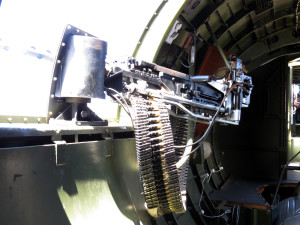
Sometimes those accumulated delays would result in timing problems and because of these, German fighters might be given time between “waves” of bombers for their fighters to land, refuel, rearm, and then….
…you could have something such as the first major attack against Schweinfurt, Germany in which the Eighth lost 60 bombers and 600 aircrew on one mission!
Imagine the feeling within those surviving crews when they were told that they would have to go back and try to finish the job. It is easy to imagine that when those surviving aircrews heard that news there was no universal groan, but rather a slow quiet exhaling combined with a silent sense of inevitability.
Before each individual squadron takeoff it required the efforts of thousands of people involved in intelligence, target selections, weather info including not just surface conditions, but winds aloft at varying altitudes as well as icing conditions, target routes, ordinance required with fusing requirements, squadron aircraft availability, aircrew availability, alternate target choices, decoys and decoy routes, fighter escort range, expected fighter attacks, known flak (anti-aircraft) installations etc.
And it all had to work seamlessly or…. some would pay the ultimate price.
As the old saying goes the ground crews especially knew the absolute necessity of getting it all right because of the all-too-truism: for want of a nail…
It was those ground personnel remaining behind who knew the quiet reality of what was termed “sweating them in” as they waited for the familiar sound of the returning bombers. (To this day if I hear the rare so-distinctive sound of a B-17 it will bring me upright out of a deep sleep. No one of that era will ever forget the unique sound of those four engines.) Everyone among the ground crews back at Deopham Green worried silently about whether or not their crew and their plane would be among the survivors … and if the landing gear was okay … and if the flaps were not shot away …if the brakes were working …if the rudder was still there …. but, worst of all, if the dreaded colored flare arced upward from a stricken aircraft and then slid over and fell slowly toward the ground indicating that there were wounded, or worse, on board.
Every man knew how many aircraft had been sent, whether there had been any “aborts”, and each man silently counted the returning bombers as they did their classic “peel off” to land. Each man hoping that if “his” plane and “his” crew were missing that “ops” would get a call telling them the welcome news that those boys had been forced to land at some other airfield in East Anglia. As each plane taxied slowly to its hardstand with usually only the outboard engines running, the sound slowly died away as props stopped turning, and the entire bomber seemed somehow to sag as if in tired relief. The crews slowly emerged, faces drawn, tired, emotionally exhausted, quietly glad that once more they had survived, and waited for the ride back to the debriefing room. Sometimes they might discuss something that had happened on the mission, but usually they just wanted to get out of their flight gear, get something to eat, and sleep, if sleep could come at all.
They tried not to notice the ambulances, or the fire trucks.
If they were very very lucky, they might get a pass to go to the railroad station at Attleborough and go to London. In London the most popular destination for the guys was the Red Cross-operated Mostyn Club near the Marble Arch because that was one place that actually had heated baths… and a guy could just lie there and soak in sheer warm relative luxury. They never knew when they might get another opportunity.
By the way, that railroad station at Attleborough is still there and on the wall is a plaque dedicated by the grateful British to the 452nd Bomb Group.
All of the squadrons had their stories and the 452nd alone had a wealth of them, some of them pleasant, some of them not, but all of them in their own way memorable.
NEXT MONTH PART III
